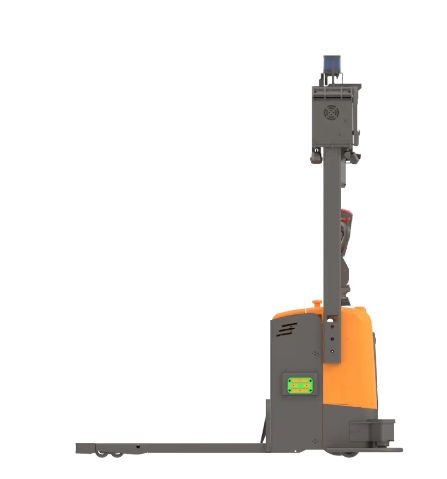Қалай Автономдық вилочы роботтар Шағын Жұмыс Иzmегiн Кеміту
Адам Операторларына Тәуелсіздікті Жалғастыру
Өзі жүретін тауар көтергіштер адам қызметкерлеріне тәуелділікті азайтады, бұл қызметкерлермен байланысты мәселелер шешіп отырған басшылар үшін үлкен салмақты азайтады. Бізнес осы технологияны енгізгенде, жалақыға жұмсалатын ақшаны үнемдеуге және жұмыс кестесін құру немесе қызметкерлердің мәселелерін шешу туралы ойлауды тоқтатуға болады. Кейбір компаниялар автоматтандырылған жүйелерге ауысқаннан кейін қоймадағы қызметкерлер санын шамамен 30% дейін қысқартқаны туралы хабарлайды. Үнемдеу тек жалақыдан ғана емес, сонымен қатар. Бұл роботтар демалу немесе жеңілдіктер пакетін қажет етпей тәулік бойы қайталанатын тапсырмаларды орындайды, сондықтан жалпы жұмыс шығындары біраз төмендейді. Көптеген логистикалық басшылар бастапқы шығындарға қарамастан бұл ауысу инвестицияға тұрарлық екенін біледі.
24/7 қызмет ететін мүмкіндіктер
Автономды тәрелкелі погрузчиктердің ерекшелігі - күн сайын үзіліссіз жұмыс істеуі. Адам жүргізушілерге демалу кезеңдері қажет, бірақ осындай роботтық машиналар тоқтамай-ақ жұмыс істей береді, яғни операциялар ешқашан тоқтамайды. Олардың тәулігіне 24 сағат, аптасына жеті күн жұмыс істеуі кейбір қоймаларда өнімділікті әлдеқайда арттыратынын көрсетті. Кейбір зерттеулер өнімділіктің белгілі бір жағдайларда нақты жартысына дейін секіріп тұруы мүмкін екенін көрсетті. Жоғары көлемдегі жұмыстармен немесе қысқа мерзімдегі тапсырыстармен айналысатын компаниялар үшін жұмыстың осындай үздіксіз жүруі жұмыстың қиын шарттарын орындауға көмектеседі.
Жұмысшылар өзгертудің азайту құны
Кәсіпорындар автономды тәрелкелі погрузчик роботтарды енгізгенде қызметкерлердің орнын босату нәтижесінде пайда болатын шығындарды да төмендетеді. Адам қызметкерлерге деген сұраныстың азаюы жалдайтын процесстерге, дайындау сессияларына және жұмыс күші нарығы тұрақсыз болған кезде өте қымбатқа түсетін қызметкерлерді ұстап тұру программаларына ақша үнемдеуге мүмкіндік береді. Кейбір кәсіпорындар автоматтандырылған жүйелерге көшкеннен кейін персонал шығындары бойынша шамамен 20% үнемдеу туралы хабарлайды. Дәл осындай үнемдеулер өндірістік орталардағы жұмыс күшіне деген ауытқымалы сұраныстармен байланысты болжамдан тыс шығындарды азайтып, қиын кезеңдерде операцияларды тұрақтандыруға көмектеседі.
Автоматтық материалдарды өңдеу арқылы еффективділікті арттыру
Инвентарь басқаруында адам хаталарын азайту
Автоматтандыру жүйесіне ауысу қолмен басқарылатын қоймадағы тауарларды басқару кезінде кездесетін адам қателерін азайтады. Ақылды алгоритмдер мен сенсорлық технологиялармен жабдықталған автономды вилкалы көтергіштер жүйеде болуы тиіс заттардың шын мәнінде қоймада бар-жоғын тексеріп отырады. Нәтижесінде компаниялар сенімді пайдалана алатын дәл қоймадағы тауарлардың саны анық болады. Бұл түрлі жетілдірулер өте маңызды, өйткені ешкім өнімдердің жоғалып кетуімен немесе пайда табыстың кемуіне әкелетін артық қойма қалдықтарымен айналысқы келмейді. Сала бойынша деректерге сүйенсек, толық автономды қоймалар дәстүрлі әдістерге қарағанда қате пайызын шамамен 90% азайтады. Әрине, ешбір жүйе жетілмеген болса да, мұндай дәлдік күнделікті операциялар мен компаниялардың нәтижелері үшін үлкен айырмашылық жасайды.
Жылдам ішкі өңдеу үшін оптималды маршрут табу
Автономды тәрелкелі көтергіштер өзінің ақылды бағдарламалық қамтамасыздығы арқасында объектілердің айналасында ең тиімді маршруттарды анықтауға өте бейімделген, олар үнемі жұмыс орындарында болып жатқан оқиғаларға сәйкес реттеліп отырады. Бұл машиналар өз жолдарын тиімді жоспарлаған кезде жұмысты тез орындап қана қоймай, сондай-ақ қоймалар мен жүк тасымалдау орындарындағы қозғалыс бөгеттерін болдырмауға көмектеседі. Жақындағы сала бойынша жасалған хабарламаларға сәйкес, кейбір компаниялар тиімді маршруттарды қолданғаннан кейін жұмыс өнімділігінің 40% артқанын байқаған. Барлық осы жұмыстың табысты болуы операциялар кезінде бәрін баяулататын қарапайым бөгеттерді азайтатын осы жүйелердің қасиетіне байланысты, яғни көбірек жүктердің орын ауыстыруы, кешігулердің азаюы және соның нәтижесінде барлық операциялардың өнімділігінің артуын білдіреді.
Салық қойылатын орындардың басқару системасымен ірі-ірі интеграция
Автономды тәрелкелі көтергіш машиналарды қазіргі қойма басқару жүйелерімен (WMS) сәйкестендіру көпшілік операциялар үшін тиімді бизнес шешім болып табылады. Бұл машиналар бағдарламамен бірге жұмыс істегенде, олар қоймадағы тауарларды түгелдеуді жақсырақ ұстап, қосымша тауарларды қолмен жүктеу үшін жұмысшыларға тәуелді болмай-ақ автоматты түрде орындайды. Тәрелкелі көтергіш машиналар үнемі WMS платформасымен байланыста болып, қоймада қандай заттар бар екені, объект ішінде олар қай жаққа қозғалып жатқаны және жаңа заттар қашан келіп жетуі керектігі туралы басқарушыларға жаңартылған ақпарат беріп отырады. Бұл түрдегі жүйелерді енгізгеннен кейін қойма басқарушылары тиімділіктің жалпы алғанда 25-30% артқанын байқаған. Қазіргі нарықта бәсекеге қабілетті болу үшін объектілерге осы технологиялардың үйлесімді жұмыс істеуін қамтамасыз ету қажеттілікке айналып келеді, әлбетте, көптеген компаниялар әлі де бастапқы жобалау шығындары мен қызметкерлердің жаңа жағдайға бейімделуі үшін қажетті дайындықты өткізу қиындық туғызып тұр.
Тауарлық қорытындыларға қолданылатын қорғаныс
Қатарлық тапсырмалардан қорғалу жүйелері
Кәсіпорындарда жұмысшылардың қауіпсіздігі әрқашан басты орындардың бірі болып қала береді, сондықтан көптеген компаниялар соңғы кезде ақылды соқтығысу дабылдау технологиясымен жабдықталған автономды вилкалы тәрелкетасымалдағыштарға көшіп жатыр. Бұл машиналар лазерлік сканерлермен, радарлық құрылғылармен және жоғары ажыратымдылықты бейне камера-лармен жабдықталған, олар жолында кездесетін кез келген затты анықтап, сақтау қоймаларындағы ортаны әлдеқайда қауіпсіз етеді. Бұл жүйелердің пайдалы әсері тек қана қоймадағы заттардың бүлінуін болдырмауға ғана емес, сонымен қатар жұмысшылардың өздеріне қауіп төндірмейтінін сезінуіне де әкеледі. Кейбір зауыттар осындай жүйелерді орнатқаннан кейін апат оқиғалар санын шамамен 60% дейін азайтқанын көрсетіп отыр, дегенмен нәтижелер жүйені пайдалану мен қолдау күйіне байланысты өзгеруі мүмкін. Бизнес тұрғысынан алғанда, осындай қауіпсіздік шараларына инвестициялар енгізу – бұл тек қана этикалық тұрғыдан дұрыс қадам ғана емес. Медициналық шығындарды, өндірістің жоғалуын және сақтандыру талаптарын болдырмау арқылы үлкен үнемдеу мүмкіндігін де береді.
Жұмыс орнындағы қауіпсізлік қажеттілігінің шектеулі берісті кеміту
Кәсіп орындарындағы апаттар компаниялар үшін жарақат алған жұмысшылар мен сынған жабдықтарды ғана емес, сонымен қатар компания бюджеттерін босататын ұзақ компенсациялық процесстерге де әкеліп соғады. Қауіпсіздік технологиялары бар автономды погрузчиктарға ауысқан кезде апаттар саны күрт төмендейді. Бұл құбылыс шын мәнінде ел бойынша қоймаларда байқалды. Жұмысшылардың компенсациялық талаптарына жұмсалатын ақшаны үнемдеу тікелей компания пайда-зиянына әсер етеді. Компаниялар тек қана ақшаны қалтаға салып қоймайды, сонымен қатар олардың операциялық қызметтерінің басқа салаларына қайта салымдар жасайды. Сонымен қатар, нақты деректер де біраз әсер ететін нәрсе көрсетеді. Толық автоматтандырылған қоймалар өткен жылы жарақат алу талаптарының 40% кемігенін хабарлады. Логистика басшыларының көпшілігі бастапқы салымдарға қарамастан осындай өзі жүретін машиналарға көшуге ықтимал себеп болып отыр.
Тегіншілік беретін страхациялық премиялар
Жұмыстағы апаттардың азаюы салық салу шығындарының төмендеуіне әкеледі, осы жағдайға көптеген автоматтандыруды қолданып жатқан компаниялар назар аударып отыр. Сақтандыру компаниялары автоматтандырылған жүйелерді жалпы алғанда қауіпсіз нұсқа ретінде қабылдайды, сондықтан олар бизнес технологияларды енгізген кезде тарифтерге жеңілдіктер береміз. Үнемдеу операциялық шығындарды қысқартуға көмектеседі және компаниялардың автоматтандыру шешімдеріне инвестиция салуын тағы да тартымды етеді. Кейбір зерттеулер автоматтандыру енгізілгеннен кейін сақтандыру шығындары шамамен 20% төмендегенін көрсетеді, бұл жұмысшылардың қауіпсіздігін арттыру мен тікелей ақшаны үнемдеу есебінен логикалық түсінікті болып табылады. Әсіресе өндірісшілер үшін автоматтандыруды дұрыс жүзеге асыру тек іздестіруді болдырмаумен ғана шектелмейді. Көптеген зауыт басшылары қайталанатын тапсырмаларды машиналар орындаған кезде жарақаттардың себеп болатын кезде басқа да бағыттар бойынша пайда көрсетіп отырғанын байқаған.
Ұзақ мерзімді сақтандыру үшін масштабталу
Қосылушы салыстырулар жоқ екенінде тексеру
Өзі жүретін вилкалы тәрелкелер жұмыс күшейтуді қажет ететін және жаңа жұмысшыларды жалдау мен қатар оларды үйрету үшін қосымша уақыт және күш салау керек болатын маусымдарда қоймаларға нақты икемділік береді. Тез өсу мүмкіндігі компаниялардың тапсырыстар кенет артқан кезде алдында болып тұрып, барлық процестерді тегіс ұстап тұруға көмектеседі. Көптеген логистика басшылары автоматтандырылған жабдықтардың дәстүрлі жүйелер мүмкіндігінен әлдеқайда көбірек жұмысты шешуге мүмкіндік беретінін байқады, бұл жағдайда қосымша жалақы шығындарын көбейтпей-ақ. Осындай операциялық күшейту компанияларға жылдамдық пен жауапкершілік әрі қарай келісім-шарттарды жеңуге немесе бәсекелестерге ұстатуға әсер ететін салаларда нақты артықшылық береді.
Постепенная расширение флота vs Постоянные затраты на рабочую силу
Бірнеше автономды тауар көтергіштерді пайдалану компанияларға қосымша қызметкерлерді жалдаудың барлық қиыншылықтарын басынан өткізбей-ақ өз қарқындарымен дамуға мүмкіндік береді. Бавырсақ дамып келе жатқан кәсіпорындар жылдам күшейіп кеткен жұмыс күшінің салдарынан туындайтын хаосты болдырмауға тырысады, сонымен қатар өндірістің үздіксіз жұмыс істеуін қамтамасыз етеді. Уақыт өте келе, шығындарды үнемдеу де нақты сомаға әкеледі. Біз адам қызметкерлеріне тұрақты төленетін жалақыны үнемдеу туралы айтып жатырмыз. Сол сияқты нақты цифрлар да осы пікірді дәлелдейді – кеңейту қажет болған сайын роботтарды қолдануға көшкен кәсіпорындар шығындарын орта есеппен төрттен бір бөлікке дейін азайтатынын сала бойынша есеп берулер көрсетіп отыр. Ойланып қарасаңыз, бұл тұжырым дұрыс болып шығады, себебі жұмыс үзілістері мен қызметкерлерді дайындауға кететін шығындар теңдеуден шығып қалады.
Прогнозлық техникалық қызметтер өшіру құжаттарынан азық-түлік траттарын қалайтын
Болжамды ұстау құрылғылардың жұмыс істеу уақытын қысқарту және операцияларды тежемей жұмыс істеу үшін маңызды болып табылады. Компаниялар нақты пайда болмай тұрып, ықтимал мәселелерді уақытылы анықтау арқылы күтпеген үзілістерге байланысты шығындарды үнемдейді және өндіріс желілерінің жұмысын үздіксіз жалғастырады. Сала бойынша деректерге қарағанда, көпшілік компаниялар осындай шараларды енгізгеннен кейін үзілістерге байланысты шығындарды үштен бір бөлікке дейін азайтады. Әсіресе өндіріс саласында мұндай түрдегі ұстау тек ақшаны үнемдеу ғана емес, сонымен қатар өнім сапасын сақтауға көмектеседі, бұл тұтынушылардың қанағаттылығы үшін өте маңызды.
Жаһандық ROI: Автоматизациядағы практикалық тапсырмалар
Амазондың операциялық заттарды 70% кеміту стратегиясы
Олардың қоймаларына автономды технологияларды енгізу арқылы Amazon операциялық шығындарды шамамен 70% дейін қысқартты. Олардың осы машиналарды тарату тәсілі автоматтандыру дәстүрлі қойма операцияларын қаншалықты өзгертетінін көрсетеді. Amazon бұл жерде тек әлдеқайда тиімділік стандартын белгілеп қана қоймайды. Бұл технологиялық шешімдерге инвестициялар салу арқылы компаниялар өз қаржылық нәтижелерін әртүрлі секторларда түбегейлі өзгерте алатынын дәлелдейді. Бұл дамуды қадағалап жүрген басқа да кәсіпкерлер маңызды нәрсені байқап жатыр, бірте-бірте көптеген адамдар осындай тәсілдерді қолданса, өз күнделікті жұмыс шығындарынан үлкен үнемдеу мүмкіндігі бар екенін түсініп жатыр.
Walmart'тың Авариясыз Склад Жобасы
Walmart өз қоймасында автоматтандырылған жүйелерді енгізуді бастаған кезде, жұмысшылардың қауіпсіздігі мен күнделікті жұмыстың тиімділігінде біраз маңызды жақсартуларға қол жеткізді. Роботтар мен автоматтандырылған процесстер нәтижесінде көптеген кәсіпорындарда жұмыс орнындағы апаттар толық жойылды, бұл шығындарды қысқартумен қатар жұмыс орындарын қауіпсіз ету мүмкін екенін көрсетеді. Бұл тәсіл басқа компаниялар үшін автоматтандыру шешімдеріне инвестиция салу туралы ойланғанда назар аударатын нақты нәрсе болып табылады. Өнеркәсіптегі басқа жерлерде болып жатқан жағдайларды қарастырсақ, көптеген компаниялар Walmart стратегиясының өз нұсқаларымен қатар жүріп, өз нақты сұраныстарына сәйкес ұқсас технологияларды бейімдеуде және ерте табыстарға ұқсас нәтижелерге қол жеткізуде.
24 айдық қайта қызметкерлік периодын қамтитын Азия manufacturing хабарлары
Азияның негізгі өндірістік орталықтарында автономды тауар көтергіш жүйелерін орнатқаннан кейін компаниялар жалпы табыстарын екі жыл ішінде қайтарып алуын байқап отыр. Бұл қысқа мерзімді қайтарым жалаң ғана қоймалардан тыс барлық түрлі өнеркәсіптік орталарда автоматтандыруды кеңейтудің өте тиімді екенін көрсетеді. Сонымен қатар, цифрлар да осыны растайды – жаңа зерттеулер робототехникалық технологиялар жетіліп келе жатқан сайын шығындарды қайтару уақыты қысқарып келеді. Шығындарды қысқартып, бірақ тиімдірек операциялар жүргізгісі келетін өндірушілер үшін бұл өзі жүретін көліктер бүкіл аймақта жақсы даму жолындағы ақылға қонбайтын қадам болып табылады.
Жиі қойылатын сұрақтар
Сұрақ 1: Автоматтық вилковые погрузчиқтар қалай жұмысшы заттарын кемиде отыратыны?
Жауап 1: Автоматтық вилковые погрузчиқтар жұмысшы операторларына қажеттілікті кеміді, қызметкерлердің басқаруын оптималаштырады және 24/7 режимінде аяқтай алатын үлгілерге сай, нәтижесінде производительность артады.
Сұрақ 2: Автоматтық вилковые погрузчиқтар қалай инвентаризация басқаруын жақсартады?
A2: Әзірлік вилочарлары инвентарь басқаруын жоғары сапалы алгоритмдер мен сенсорлер арқылы адам қателерін кемиді, осылайша салдардың дұрыс түрде сақталуын және деректердің толықтығын taртады.
Q3: Әзірлік вилочарлары қандай қауіпсіздік қасиеттерін береді?
A3: Әзірлік вилочарлары кез келген қоршайды анықтау мүмкіндігі бар қалайынасыз қауіпсіздік системаларымен осналенген, бұл жергіліктегі несептерді көбейтуге және жалпы қауіпсіздікке сайлауға көмектеседі.
Q4: Автоматтық қандай тәсілдер арқылы шағын қызметкерлердің ауыстыруынан туындаған қаржылық заттарды әсер етеді?
A4: Автоматтық процесстер адам қызметкерлерінің санын азайту арқылы шағын қызметкерлердің ауыстыруынан туындаған қаржылық заттарды кемиді, сондықтан салыстыру, бағдарламалау және сақтау программаларымен байланысты заттарды көбейтуді қалаймыз.
Сұрақ 5: Жұмыс орнындағы инциденттерді кемітуге қандай финансиялық пайдар бар?
Жауап 5: Жұмыс орнындағы инциденттердің кемуі, салықтардың азайтуына және страхталу төлемдерінің кемуіне мүлдейді, бұл да əнік қаржылық сақтамаларына мүндірік береді.

